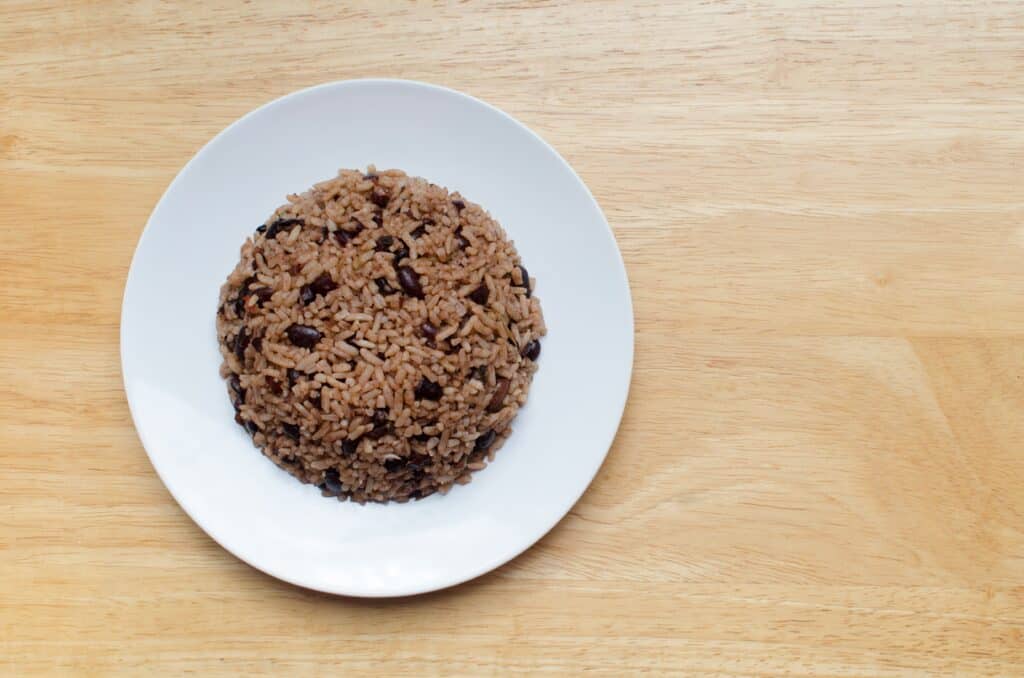Last updated on October 6th, 2023 at 02:37 pm

Gallo Pinto, a humble yet flavorful dish, is the heart of Nicaraguan cuisine. It’s a simple combination of rice and beans, often served as a breakfast staple but enjoyed at any time of day.
Learn more about Gallo Pinto and how to make your own at home with this guide that our team at Remitly created.
This guide is for you as part of our series that celebrates the traditional foods of our global customers.
The Origins of Gallo Pinto
The history of Gallo Pinto is steeped in the cultural fabric of Nicaragua. Its name translates to “spotted rooster,” an apt description for the speckled appearance created by mixing white rice and black or red beans.
This dish has been appreciated by generations, its origins tracing back to the indigenous people who inhabited Central America long before European colonization.
While it’s difficult to pinpoint exactly when Gallo Pinto was first prepared, it’s clear that this dish has deep roots in Nicaraguan culture.
Ingredients Used in Gallo Pinto
The beauty of Gallo Pinto lies in its simplicity. The primary ingredients are rice and beans—typically red or black. These are cooked separately before being combined with sautéed onions and bell peppers.
Garlic, salt, and pepper add depth to the flavor profile while Worcestershire sauce—a favored addition in many Nicaraguan households—gives it a tangy kick. Some cooks also add cilantro for freshness or Salsa Lizano for an extra layer of complexity.
Step-by-Step Recipe for Gallo Pinto
Ingredients:
- 1 cup of long-grain white rice
- 2 cups of water
- 1 can (15 oz) of black or red beans, drained and rinsed
- 2 tablespoons of vegetable oil
- 1 medium onion, finely chopped
- 1 bell pepper, finely chopped
- 2 cloves of garlic, minced
- Salt and pepper to taste
- Worcestershire sauce (optional)
- Fresh cilantro leaves (optional)
- Salsa Lizano (optional)
Instructions:
- Rinse the rice under cold water until the water runs clear.
- In a pot, bring the water to a boil. Add the rice and reduce heat to low. Cover and let it simmer until the rice is tender—about 20 minutes.
- While the rice is cooking, heat the oil in a large skillet over medium heat.
- Add onions and bell peppers to the skillet and sauté until they’re soft—about five minutes.
- Stir in garlic and cook for another minute.
- Add beans into the skillet along with salt and pepper. Cook for about five minutes until heated through.
- Once the rice is cooked, add it into the skillet with beans mixture.
- Stir everything together until well combined—the grains should be speckled with beans throughout.
- If desired, add Worcestershire sauce or Salsa Lizano for extra flavoring.
- Garnish with fresh cilantro leaves before serving.
Variations of Gallo Pinto Across Nicaragua
While the basic recipe for Gallo Pinto remains consistent across Nicaragua, regional variations do exist. In the northern highlands, red beans are often used instead of black ones.
Some regions add vegetables like carrots and peas to their Gallo Pinto. Others might include meat or seafood—though this isn’t common. Regardless of these differences, the essence of Gallo Pinto—a simple yet satisfying combination of rice and beans—remains unchanged.
Serving Suggestions for Gallo Pinto
Gallo Pinto can be served at any time of day—from breakfast to dinner. It’s often accompanied by fried eggs or cheese in the morning or served alongside grilled meat or fish later in the day.
For a truly Nicaraguan experience, try pairing your Gallo Pinto with plantains—either sweet or savory—or a fresh salad. And don’t forget a dollop of crema—a type of sour cream—for added richness.
Popular Pairings with Gallo Pinto
In addition to being served as a standalone dish, Gallo Pinto often accompanies other traditional Nicaraguan foods. It pairs well with carne asada (grilled meat), pollo guisado (stewed chicken), and pescado frito (fried fish).
Plantains—whether fried until crispy or boiled and mashed—are another popular accompaniment. If you enjoy heat, pickled onions and jalapeños provide a spicy contrast to the mild flavors of Gallo Pinto.
Nicaraguan Cuisine: A Blend of Cultures
Nicaraguan cuisine reflects its rich cultural history—a blend of indigenous traditions mixed with Spanish influences.
Corn: The Staple Ingredient
Corn is a staple in Nicaraguan cuisine, used in everything from drinks to desserts.
It’s the main ingredient in dishes like nacatamales—corn dough filled with meat or cheese and wrapped in banana leaves—and indio viejo—a thick stew made with cornmeal, meat, and vegetables.
Seafood Delights
Nicaragua’s extensive coastline means seafood plays a significant role in its cuisine. Fish, shrimp, and lobster are often grilled or fried and served with rice or plantains.
Fruits and Vegetables
Fruits and vegetables are abundant in Nicaragua. They’re used not only as side dishes but also as main ingredients in soups and stews. Plantains are particularly popular—served boiled, fried, or mashed.
Sweet Treats
Nicaraguans have a sweet tooth. Desserts often feature local fruits like mangoes and pineapples along with staples like rice and corn. Leche flan—a creamy custard dessert—is a favorite.
In conclusion, Nicaraguan cuisine is diverse yet unified by its reliance on fresh, local ingredients.
Whether it’s a hearty plate of Gallo Pinto or a refreshing glass of chicha—a traditional corn drink—it offers something for everyone.
Visit the homepage, download our app, or check out our Help Center to get started.
